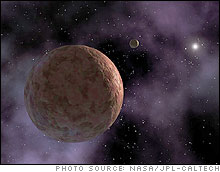 Artist's rendition of the planetoid Sedna |
On March 15, 2004, astronomers confirmed the discovery of the most distant object ever identified in our solar system. Twice as far from the Sun as any known object, this red mass has an unusually elliptical orbit that takes a staggering 10,500 years to complete. Officially called 2003 VB12, its discoverers claim that it is the first known object from the long-hypothesized Oort Cloud, believed to be home to billions of frozen comets. The object's surface temperature is about minus 400°F (minus 240°C). Its frigid celestial homeland inspired its informal name, Sedna, the Inuit goddess of the icy northern oceans. In addition to its unparalleled coldness and distance, Sedna also distinguishes itself as the largest object identified since Pluto's discovery in 1930. About three-quarters of the size of Pluto, it is considered a planetoid (a minor planet or asteroid). Thought to be composed of rock and ice, it has a reddish hue similar to that of Mars.
In the process of defining Sedna, poor Pluto's fragile standing as a planet has once again come under attack—you may recall that unpleasant business back in 1999 when rumors circulated in the press darkly hinting that Pluto was in danger of a demotion. The International Astronomical Union (IAU) even found it necessary to issue a press release reassuring a distraught public that “no proposal to change the status of Pluto as the ninth planet” was in the works. But while the IAU continues to stand by Pluto, plenty of astronomers would like to wrest it from the company of its eight planetary brethren, pointing out that Pluto has less family resemblance to sublime Saturn than to brassy little Sedna. One of Sedna's discoverers, Mike Brown of the California Institute of Technology, makes a compelling case against Pluto, though coming from a partisan of the new planetoid, it's not nearly as cold-blooded as you might expect:
Either Pluto is not a planet, or many other things are planets. Which is a better choice? I want my planets to be more special, not less special, so I favor Pluto not being a planet. Emotionally, though, I have to admit that I have grown up thinking Pluto is this special odd-ball planet at the edge of the solar system. While I now know scientifically that Pluto is less special, it's still hard to let go.
What with quasars, red giants, and brown dwarfs presumably taking up their time, why are astronomers still arguing about something as fundamental as whether Pluto deserves to be called a planet? Astonishingly, there's no official scientific definition of a planet, beyond a few principles: it must orbit a star and be spherical, and it cannot have been subject to internal nuclear fusion, which would make it a star. Astronomer Gibor Basri of the University of California, Berkeley, admits, “It's something of an embarrassment that we currently have no definition of what a planet is. People like to classify things. We live on a planet; it would be nice to know what that was.”
Back when astronomers first welcomed Pluto into the solar system, it was thought to be the fifth largest planet, 12% larger than our own. Not only has sophisticated astronomical measurement reduced it to ninth place, but given that astronomers have only scratched the surface of the sky—surveying just 15% so far—there are sure to be even bigger, more brazen Sednas in Pluto's future.




